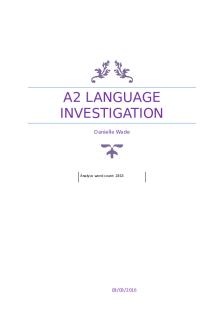English Language learners need oral language PDF

| Title | English Language learners need oral language |
|---|---|
| Course | child literacy 2 |
| Institution | Southern Connecticut State University |
| Pages | 2 |
| File Size | 35.8 KB |
| File Type | |
| Total Downloads | 22 |
| Total Views | 150 |
Summary
note...
Description
-
English Language learners need oral language
-
Oral language is the precursor to print
-
English Language learners are coming with speaking languages other than English. Teacher need to elicit talk through grand conversations where we ask really big openended wondering questions. For example, when you are reading a book you ask a big question that doesn’t have a right or wrong answer therefore, they elicit extended talk and you hold your evaluation by pausing and thinking and in that pause you are inviting more talk
-
Small group work comes from vygotsys ideas of interaction
-
Being grouped with the plus one students who know a little bit more allows us to learn more
-
English language learners need to hear the language used by peers’
-
Reading aloud to students and using diologic reading when you are reading aloud and you are modeling
Diologic Reading -
In a read aloud, the adult reads and the students listen
-
The adults become questioners during their reading so that students can become thinkers as well as listeners
-
There are 5 types of prompts in dialogic reading
-
The acronym CROWD is used for these prompts. Each letter stands for another prompt o C is for completion promts- in this prompt the teacher leaves a blank at the end of a sentence and the child fills it in
o R is for recall prompts- the teacher asks questions about what happened in the book and the children have to remember to be able to answer o O is for open ended prompts- the teacher asks questions about the pictures in the book and the students have to explain what is happening in the pictures o WH is for questions that begin with what, where, why, when, and how o D is for distancing prompts- the teacher asks questions for students to make connections to themselves, their world, and their own experiences. The student connect the book to themselves....
Similar Free PDFs

English Language Teaching
- 9 Pages

English Language Teaching
- 7 Pages

English Language investigation
- 26 Pages

A level English Language
- 18 Pages

English Language - Jonathan Culpeper
- 33 Pages

English Language Teaching
- 16 Pages

English language terms
- 1 Pages

Practical English Language Teaching.pdf
- 353 Pages

Language
- 2 Pages

Riassunti language to language
- 38 Pages
Popular Institutions
- Tinajero National High School - Annex
- Politeknik Caltex Riau
- Yokohama City University
- SGT University
- University of Al-Qadisiyah
- Divine Word College of Vigan
- Techniek College Rotterdam
- Universidade de Santiago
- Universiti Teknologi MARA Cawangan Johor Kampus Pasir Gudang
- Poltekkes Kemenkes Yogyakarta
- Baguio City National High School
- Colegio san marcos
- preparatoria uno
- Centro de Bachillerato Tecnológico Industrial y de Servicios No. 107
- Dalian Maritime University
- Quang Trung Secondary School
- Colegio Tecnológico en Informática
- Corporación Regional de Educación Superior
- Grupo CEDVA
- Dar Al Uloom University
- Centro de Estudios Preuniversitarios de la Universidad Nacional de Ingeniería
- 上智大学
- Aakash International School, Nuna Majara
- San Felipe Neri Catholic School
- Kang Chiao International School - New Taipei City
- Misamis Occidental National High School
- Institución Educativa Escuela Normal Juan Ladrilleros
- Kolehiyo ng Pantukan
- Batanes State College
- Instituto Continental
- Sekolah Menengah Kejuruan Kesehatan Kaltara (Tarakan)
- Colegio de La Inmaculada Concepcion - Cebu





